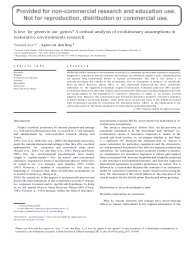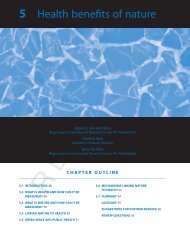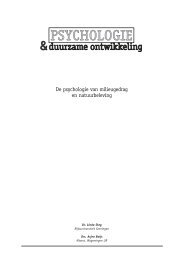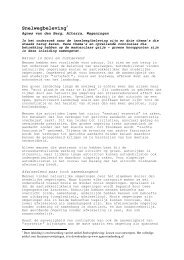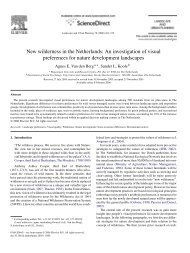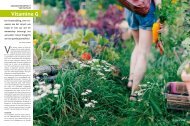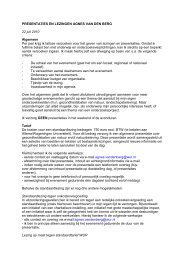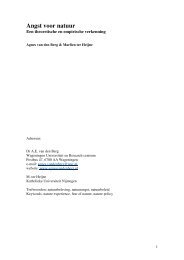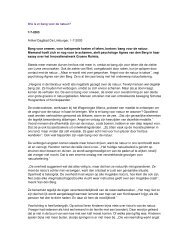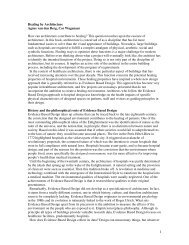healing environments in radiotherapy - Agnes van den Berg
healing environments in radiotherapy - Agnes van den Berg
healing environments in radiotherapy - Agnes van den Berg
Create successful ePaper yourself
Turn your PDF publications into a flip-book with our unique Google optimized e-Paper software.
Heal<strong>in</strong>g Environments <strong>in</strong> Radiotherapy Project Report<br />
Patients, staff and decision makers may not (yet) be will<strong>in</strong>g or able to engage <strong>in</strong> a process of<br />
transformation towards a more ‘holistic’ approach to <strong>heal<strong>in</strong>g</strong><br />
A non-traditional approach can encounter problems with government and <strong>in</strong>surance<br />
regulations<br />
Costs may rise due to <strong>in</strong>creased adm<strong>in</strong>istration, health and malpractice <strong>in</strong>surance premiums<br />
and reduced reimbursements<br />
Fear of litigation can lead to <strong>in</strong>creased costs and tension and may <strong>in</strong>hibit people to try a new<br />
approach<br />
Some implementations may have adverse effects on certa<strong>in</strong> patients (e.g. daylight can have<br />
adverse effects on people who are sensitive to ultra-violet radiation)<br />
All these factors need consideration before decid<strong>in</strong>g on whether to make design implementations to<br />
create a <strong>heal<strong>in</strong>g</strong> environment. It is noteworthy however, that most known disad<strong>van</strong>tages are<br />
concerned with rather structural or bureaucratic issues. From a moral standpo<strong>in</strong>t, this should not<br />
outweigh the significant ad<strong>van</strong>tages <strong>heal<strong>in</strong>g</strong> <strong>environments</strong> can offer <strong>in</strong> terms of health outcomes;<br />
after all, most forms of <strong>in</strong>novation are likely to <strong>in</strong>itially encounter structural ‘roadblocks’ and<br />
negative attitudes. Hence, it is fair to say that, <strong>in</strong> general, healthcare sett<strong>in</strong>gs should be encouraged<br />
to implement measures towards the creation of <strong>heal<strong>in</strong>g</strong> <strong>environments</strong>.<br />
2.2 Physical factors<br />
Architecture cannot heal, but it can provide an environment that supports people <strong>in</strong> cop<strong>in</strong>g with<br />
stress or other symptoms of illness (Hesta, 2008). There are several physical attributes of healthcare<br />
<strong>environments</strong> which have been shown to <strong>in</strong>fluence patients as well as visitors and staff. The most<br />
important factors are summarised below.<br />
Light<strong>in</strong>g<br />
In general, researchers agree that proper light<strong>in</strong>g is an important<br />
issue and that healthcare sett<strong>in</strong>gs should not be too dim. For<br />
<strong>in</strong>stance, it has been shown that hospital rooms with poor light<strong>in</strong>g<br />
can alter circadian rhythms, which causes negative effects like eye<br />
fatigue and headaches. In addition, staff will make fewer errors <strong>in</strong><br />
brighter surround<strong>in</strong>gs (Devl<strong>in</strong> & Arneill, 2003). However, one expert<br />
po<strong>in</strong>ts out that light is the most important element of <strong>heal<strong>in</strong>g</strong> <strong>environments</strong>, and that harsh light<br />
should be avoided because it can be very annoy<strong>in</strong>g for patients to look <strong>in</strong>to (A. Kw<strong>in</strong>t, Plants for<br />
People).<br />
A significant amount of literature on <strong>heal<strong>in</strong>g</strong> <strong>environments</strong> is concerned with a debate about the<br />
ad<strong>van</strong>tages and disad<strong>van</strong>tages of natural light versus artificial light. Some k<strong>in</strong>ds of artificial light<strong>in</strong>g<br />
have been shown to be beneficial. For example, the use of ultraviolet light has been proven to<br />
decrease blood pressure, which <strong>in</strong> turn can help to <strong>in</strong>crease prote<strong>in</strong> metabolism, decrease fatigue,<br />
and <strong>in</strong>crease the release of endorph<strong>in</strong>s (Altimier, 2004). However, certa<strong>in</strong> aspects of <strong>in</strong>-door light<strong>in</strong>g,<br />
such as lum<strong>in</strong>ance level, lamp colour, and flicker have been argued to affect mood and performance<br />
<strong>in</strong> a negative way. For <strong>in</strong>stance, Knez (1995), study<strong>in</strong>g the effect of lum<strong>in</strong>ance levels, compared the<br />
12



